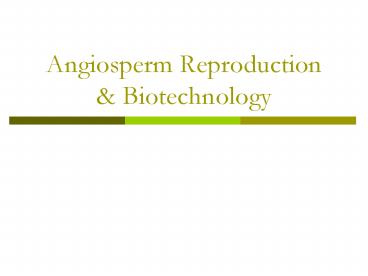Angiosperm Reproduction - PowerPoint PPT Presentation
1 / 21
Title:
Angiosperm Reproduction
Description:
Angiosperm Reproduction & Biotechnology Alternation of Generations (Revisited) The life cycle of angiosperms and other plants are characterized by an alternation of ... – PowerPoint PPT presentation
Number of Views:156
Avg rating:3.0/5.0
Title: Angiosperm Reproduction
1
Angiosperm Reproduction Biotechnology
2
Alternation of Generations (Revisited)
- The life cycle of angiosperms and other plants
are characterized by an alternation of
generations, in which haploid (n) and diploid
(2n) generations take turns producing each other - Diploid plant (sporophyte) produces haploid
spores by meiosis - These haploid spores divide by mitosis, producing
gametophytes - These small male and female haploid plants
(gametophytes) produce gametes - Gametes unite through fertilization, resulting in
a diploid zygote - The zygote divides by mitosis, producing the new
sporophyte
3
Alternation of Generations
4
A Review of Flower Structure
- Flowers are the reproductive structures of
flowering plants - Review structure of an idealized flower
- Male parts?
- Female parts?
5
Flower Vocabulary
- Complete vs. incomplete flowers
- Complete flowers have all 4 floral parts
(sepals, petals, stamens, carpels) - Incomplete flowers missing at least one floral
part - Perfect vs. imperfect flowers
- Perfect flowers have both stamens and carpels
- Imperfect flowers are missing either stamens or
carpels
6
Flower Vocabulary
- Monoecious vs. Dioecious Plants
- Plant species are monoecious (one house) if the
male and female parts are found on the same
individual plant - Plant species are dioecious (two houses) if the
male and female parts are found on separate
plants
7
Dioecious Plants
8
Pollination
- Pollination is the placing of pollen onto the
stigma of a carpel - Pollination is accomplished either by wind or by
animals - A pollen grain absorbs moisture and produces a
pollen tube that extends down the style to the
ovary - The pollen grain divides by mitosis and produces
two sperm - One sperm cell fertilizes the egg to form the
zygote - The other sperm cell combines with the two polar
bodies to form a triploid (3n) nucleus - This cell will become the endosperm, which serves
as a food source to the developing embryo - This process (double fertilization) ensures that
the endosperm (food source) will develop only in
ovules where the egg has been fertilized
9
(No Transcript)
10
From Ovule to Seed
- After double fertilization, the ovule will
develop into a seed - The seed dehydrates as it nears the end of its
maturation - The embryo and its food supply (cotyledons,
endosperm or both) are enclosed by a hard,
protective seed coat
11
Seed Structure
- The radicle is the root of the embryo and where
germination begins - The part of the seed below the point at which the
cotyledons are attached is called the hypocotyl - The portion of the embryonic axis above the
cotyledons is the epicotyl
12
Seed Structure
13
From Ovary to Fruit
- After double fertilization, the ovary will
develop into a fruit enclosing the seed - The fruit protects the seeds inside and aids in
dispersal (by wind or animals)
14
Fruits
- Simple Fruits
- A fruit derived from a single ovary
- Can be fleshy (cherry) or dry (soybean pod)
- Aggregate Fruit
- A fruit that results from a single flower that
has several separate carpels - Blackberries, strawberries
- Multiple Fruit
- Develops from a group of separate flowers tightly
clustered together - Pineapple
15
Seed Dormancy
- Seed dormancy means that a seed will not
germinate, even if sown in a favorable place,
until a specific environmental cue causes them to
break dormancy - Seed dormancy increases the chances that
germination will occur at a time and place most
advantageous to the seedling - How did we break dormancy in our lab??
16
Stages of Seed Germination
- The seed absorbs water, causing it to expand and
rupture its seed coat - The embryo resumes growth, digesting the storage
materials of the endosperm - The radicle (embryonic root) emerges from the
germinating seed - The shoot tip breaks through the soil surface
17
Stages of Seed Germination
18
Asexual Reproduction
- Book Analogy
- Some of your fingers separate from your body, and
eventually develop into entire copies of
yourself! - When plant species clone themselves by asexual
reproduction, its known as vegetative
reproduction
19
Asexual Reproduction
- Fragmentation is the separation of a parent plant
into parts that re-form whole plants - This type of asexual reproduction is used to
produce clones from cuttings (common with
houseplants)
20
Plant Biotechnology Agriculture
- Artificial Selection
- Favorable traits can be selected for by using
selective breeding tactics - Example maize
- Maize (corn ?) has been selectively bred to
contain higher levels of protein for consumption
in developing countries
21
Reducing World Hunger Malnutrition
- 800,000,000 people on Earth suffer from
nutritional deficiencies - 40,000 people die each day of malnutrition
- Increasing food production is an important part
of addressing this global issue - There is a limited amount of land and water
available for farming - The best option is to increase the productivity
of the land currently being farmed - Developing transgenic plants that are resistant
to herbicides and repel insects without the use
of pesticides and increasing the nutritional
quality of plants are possible with modern
biotechnology techniques - However, the use of biotechnology in the
production of genetically modified plants is
controversial































